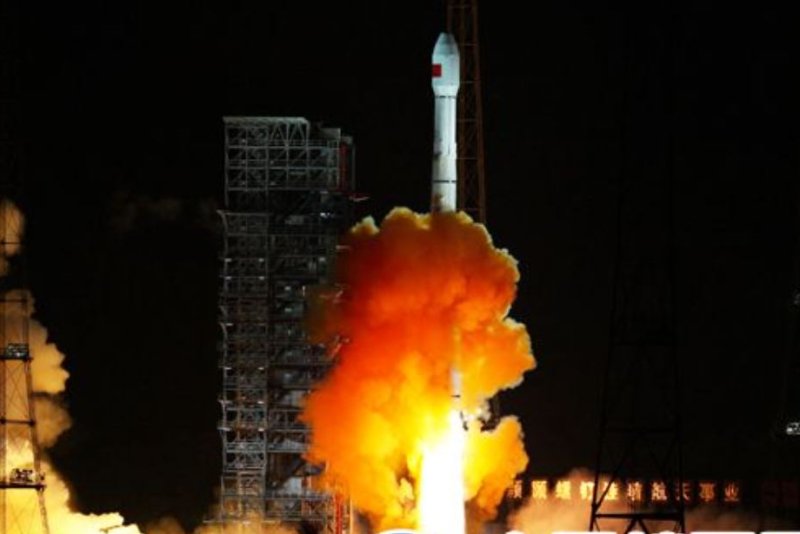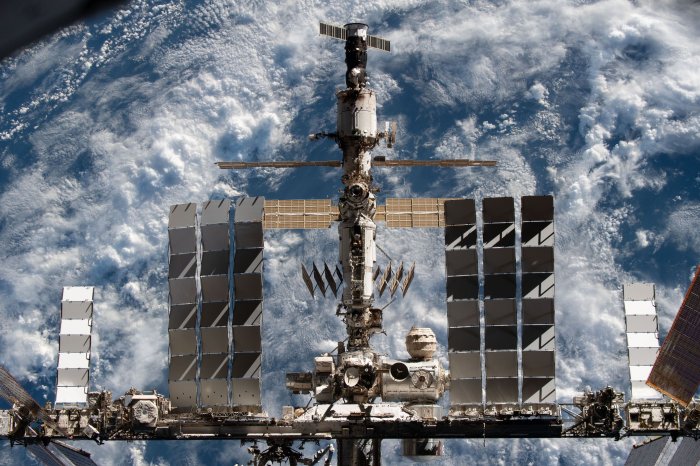China denies rocket set for moon crash was from 2014 Chinese mission

The moon is seen during a partial lunar eclipse in Shanghai
Mon, February 21, 2022,
BEIJING (Reuters) - China's foreign ministry on Monday denied a U.S. report that a spent rocket booster forecast to crash on the far side of the moon next month was debris from a Chinese lunar mission in 2014.
The rocket booster, expected to crash on the moon on March 4, was initially identified by an independent researcher as a used Falcon rocket stage from Elon Musk's SpaceX.
However, earlier this month the U.S. National Aeronautics and Space Administration (NASA) said its analysis showed that the object was likely to be the booster rocket from China's Chang'e 5-T1 mission launched in 2014.
China launched the uncrewed Chang'e 5-T1 spacecraft to the moon in October 2014 on a Long March 3C rocket, which has three stages.
The mission was to test the ability of the spacecraft's capsule to re-enter Earth's atmosphere. The capsule landed back on Earth that same month.
"According to China's monitoring, the Chang'e 5 (rocket) has safely entered Earth's atmosphere, and has completely burned," said Wang Wenbin, a Chinese foreign ministry spokesman, when asked by reporters if the object was from the Chinese mission.
The near decade-long voyage of the suspected rocket booster has re-ignited discussion about space debris and who is legally responsible for tracking junk floating outside the Earth's atmosphere.
"China follows international law for development of space affairs, and will safeguard the long-term development of outer space activities and conduct wider consultations with relevant sides," Wang said.
(Reporting by Emily Chow and Ryan Woo, Editing by William Maclean)
Ahead of lunar rocket crash, astronomers call for better space debris tracking

China launches the Chang'e-5 T1 in October 2014 on a Long March rocket.

RELATED China, Russia to start building lunar research station by 2026
"In the past, everyone has been rather careless about where high-orbiting debris went," Gray said. He wrote software known as Project Pluto to track such objects, which astronomers use as part of their hunt for near-Earth asteroids that could pose a threat.
But Gray said new Deep Space missions to the moon and Mars make it more important to know where such items are headed.
Gray's initial suggestion that SpaceX was the originator prompted media around the world to report on his finding. Students at the University of Arizona studied the composition of the object, and confirmed it matched Chinese rockets, not Falcon 9.
RELATED NASA, private space industry may reach new heights in 2022
After he corrected himself, some accused him and the media of being unfair to SpaceX.
Gray suggests a new organization be established to track such debris, and that nations agree to require accurate data for any Deep Space launches -- if not requiring such missions ensure that space debris is disposed of safely somehow.
As it is, Gray said the object probably won't cause significant damage on the moon, but it may create a crater about the size of a tractor-trailer truck in diameter when it hits around 7:25 a.m. EST on March 4.
The impact won't be visible from Earth due to the curvature of the moon, but satellites may observe the impact crater afterward.
Other astronomers have followed the moon collision predictions as they unfolded with interest, including Harvard astrophysicist Jonathan McDowell.
"Really, we should know where our space junk is, right? There's a due diligence factor here that should apply," McDowell, who studies satellite tracking data and works at the Harvard-Smithsonian Center for Astrophysics in Massachusetts, told UPI in an interview.
But like others, McDowell focuses mostly on low-Earth orbit where the vast majority of satellites are. He said Deep Space is like the Wild West of space tracking, and no one is really funded to track such objects. Radar on Earth isn't strong enough to track such debris, so telescopes are required.
Debris close to the moon is even harder to track because calculations of how lunar gravity influences an orbit aren't certain to be accurate without radio telemetry, and most debris isn't sending signals, he said.
"Someone should do it, particularly with astronauts heading to the moon again," he said. "I think it would be better if NASA were given the job, rather than the Space Force, because it will be important for civil and military missions in the future."

The International Space Station is pictured from the SpaceX Crew Dragon Endeavour during a flyaround of the orbiting lab
China launches the Chang'e-5 T1 in October 2014 on a Long March rocket.
Photo by CNSA
ORLANDO, Fla., Feb. 21 (UPI) -- A mixup among leading astronomers about a rocket that will crash into the moon on March 4 has led to calls for better debris tracking of Deep Space manufactured objects.
Independent astronomer Bill Gray, of Maine, one of few astronomers who track human-made objects in Deep Space, discovered in January that a section of a discarded rocket would crash into the moon.
Due to earlier miscalculations and a general lack of data available, he thought the object was a SpaceX Falcon 9 upper stage that launched the U.S.'s Deep Space Climate Observatory, in early 2015.
But later, he and others in the astronomy community realized the accidental moon collider is part of a Chinese Long March rocket that sent the Chang'e-5 T1 lunar test probe into space in 2014.
ORLANDO, Fla., Feb. 21 (UPI) -- A mixup among leading astronomers about a rocket that will crash into the moon on March 4 has led to calls for better debris tracking of Deep Space manufactured objects.
Independent astronomer Bill Gray, of Maine, one of few astronomers who track human-made objects in Deep Space, discovered in January that a section of a discarded rocket would crash into the moon.
Due to earlier miscalculations and a general lack of data available, he thought the object was a SpaceX Falcon 9 upper stage that launched the U.S.'s Deep Space Climate Observatory, in early 2015.
But later, he and others in the astronomy community realized the accidental moon collider is part of a Chinese Long March rocket that sent the Chang'e-5 T1 lunar test probe into space in 2014.
A Chinese Long March 3 rocket launches from China in 2019. Photo courtesy of CNSA
RELATED China returns moon samples from Chang'e 5 spacecraft
"As far as I know, I'm the only one keeping track of these objects, using observations made by the asteroid tracking community," Gray told UPI in an interview.
Most satellites orbit the Earth in a low orbit about 600 miles up, including the International Space Station. Many others orbit within about 22,000 miles from Earth, known as geostationary.
But Gray tracks a few dozen pieces of space trash that fly in very high orbits, closer to the moon, which is 238,900 miles from Earth.
"As far as I know, I'm the only one keeping track of these objects, using observations made by the asteroid tracking community," Gray told UPI in an interview.
Most satellites orbit the Earth in a low orbit about 600 miles up, including the International Space Station. Many others orbit within about 22,000 miles from Earth, known as geostationary.
But Gray tracks a few dozen pieces of space trash that fly in very high orbits, closer to the moon, which is 238,900 miles from Earth.
RELATED China, Russia to start building lunar research station by 2026
"In the past, everyone has been rather careless about where high-orbiting debris went," Gray said. He wrote software known as Project Pluto to track such objects, which astronomers use as part of their hunt for near-Earth asteroids that could pose a threat.
But Gray said new Deep Space missions to the moon and Mars make it more important to know where such items are headed.
Gray's initial suggestion that SpaceX was the originator prompted media around the world to report on his finding. Students at the University of Arizona studied the composition of the object, and confirmed it matched Chinese rockets, not Falcon 9.
RELATED NASA, private space industry may reach new heights in 2022
After he corrected himself, some accused him and the media of being unfair to SpaceX.
Gray suggests a new organization be established to track such debris, and that nations agree to require accurate data for any Deep Space launches -- if not requiring such missions ensure that space debris is disposed of safely somehow.
As it is, Gray said the object probably won't cause significant damage on the moon, but it may create a crater about the size of a tractor-trailer truck in diameter when it hits around 7:25 a.m. EST on March 4.
The impact won't be visible from Earth due to the curvature of the moon, but satellites may observe the impact crater afterward.
Other astronomers have followed the moon collision predictions as they unfolded with interest, including Harvard astrophysicist Jonathan McDowell.
"Really, we should know where our space junk is, right? There's a due diligence factor here that should apply," McDowell, who studies satellite tracking data and works at the Harvard-Smithsonian Center for Astrophysics in Massachusetts, told UPI in an interview.
But like others, McDowell focuses mostly on low-Earth orbit where the vast majority of satellites are. He said Deep Space is like the Wild West of space tracking, and no one is really funded to track such objects. Radar on Earth isn't strong enough to track such debris, so telescopes are required.
Debris close to the moon is even harder to track because calculations of how lunar gravity influences an orbit aren't certain to be accurate without radio telemetry, and most debris isn't sending signals, he said.
"Someone should do it, particularly with astronauts heading to the moon again," he said. "I think it would be better if NASA were given the job, rather than the Space Force, because it will be important for civil and military missions in the future."

The International Space Station is pictured from the SpaceX Crew Dragon Endeavour during a flyaround of the orbiting lab
No comments:
Post a Comment